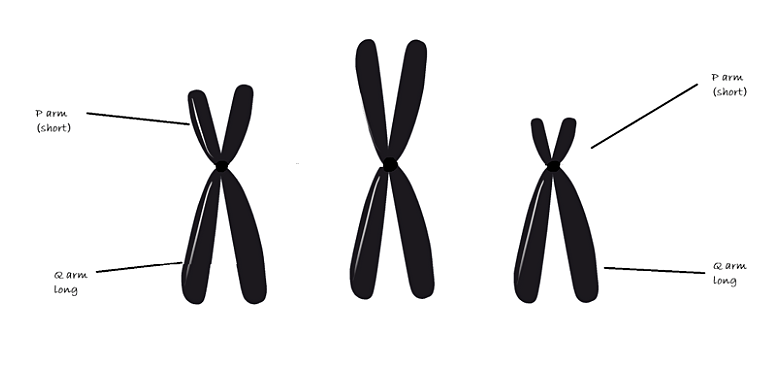
The long and short arms of the chromosome are designated as respectively.
A. p and q arms
B. q and p arms
C. m and p arms
D. i and s arms
Answer
471.6k+ views
Hint: A chromosome is a long DNA molecule with part or all of the genetic material of an organism. Most eukaryotic chromosomes include packaging proteins called histones which, aided by chaperone proteins, bind to and condense the DNA molecule to maintain its integrity. These chromosomes display a complex three-dimensional structure, which plays a significant role in transcriptional regulation.
Complete answer: Chromosomal recombination during meiosis and subsequent sexual reproduction plays a significant role in genetic diversity. Each eukaryotic chromosome consists of a long linear DNA molecule associated with proteins, forming a compact complex of proteins and DNA called chromatin. Chromatin contains the vast majority of the DNA of an organism, but a small amount of inherited maternally can be found in the mitochondria. Several chromosome regions have been defined by convenience to talk about gene loci. Most important is the distinction between chromosome region p and chromosome region q. These are virtual regions that exist in all chromosomes. During cell division, the molecules that compose chromosomes (DNA and proteins) undergo chromatin condensation that forms a compact and small complex called a chromatid. The complexes containing the duplicated DNA molecules, the sister chromatids, are attached by the centromere. The centromere divides each chromosome into two regions: the smaller one, which is the p region, and the bigger one, the q region. The sister chromatids will be distributed to each daughter cell at the end of the cell division.

Hence, the correct option is (B)-q and p arms.
Note: The p region is represented in the shorter arm of the chromosome while the q region is in the larger arm. At either end of a chromosome is a telomere, a cap of DNA that protects the rest of the chromosome from damage. The areas of the p and q regions close to the telomeres are the subtelomeres or subtelomeric regions. The areas closer to the centromere are the pericentromeric regions.
Complete answer: Chromosomal recombination during meiosis and subsequent sexual reproduction plays a significant role in genetic diversity. Each eukaryotic chromosome consists of a long linear DNA molecule associated with proteins, forming a compact complex of proteins and DNA called chromatin. Chromatin contains the vast majority of the DNA of an organism, but a small amount of inherited maternally can be found in the mitochondria. Several chromosome regions have been defined by convenience to talk about gene loci. Most important is the distinction between chromosome region p and chromosome region q. These are virtual regions that exist in all chromosomes. During cell division, the molecules that compose chromosomes (DNA and proteins) undergo chromatin condensation that forms a compact and small complex called a chromatid. The complexes containing the duplicated DNA molecules, the sister chromatids, are attached by the centromere. The centromere divides each chromosome into two regions: the smaller one, which is the p region, and the bigger one, the q region. The sister chromatids will be distributed to each daughter cell at the end of the cell division.

Hence, the correct option is (B)-q and p arms.
Note: The p region is represented in the shorter arm of the chromosome while the q region is in the larger arm. At either end of a chromosome is a telomere, a cap of DNA that protects the rest of the chromosome from damage. The areas of the p and q regions close to the telomeres are the subtelomeres or subtelomeric regions. The areas closer to the centromere are the pericentromeric regions.
Latest Vedantu courses for you
Grade 10 | MAHARASHTRABOARD | SCHOOL | English
Vedantu 10 Maharashtra Pro Lite (2025-26)
School Full course for MAHARASHTRABOARD students
₹31,500 per year
Recently Updated Pages
Express the following as a fraction and simplify a class 7 maths CBSE

The length and width of a rectangle are in ratio of class 7 maths CBSE

The ratio of the income to the expenditure of a family class 7 maths CBSE

How do you write 025 million in scientific notatio class 7 maths CBSE

How do you convert 295 meters per second to kilometers class 7 maths CBSE

Write the following in Roman numerals 25819 class 7 maths CBSE

Trending doubts
State and prove Bernoullis theorem class 11 physics CBSE

What are Quantum numbers Explain the quantum number class 11 chemistry CBSE

Write the differences between monocot plants and dicot class 11 biology CBSE

1 ton equals to A 100 kg B 1000 kg C 10 kg D 10000 class 11 physics CBSE

State the laws of reflection of light

One Metric ton is equal to kg A 10000 B 1000 C 100 class 11 physics CBSE




